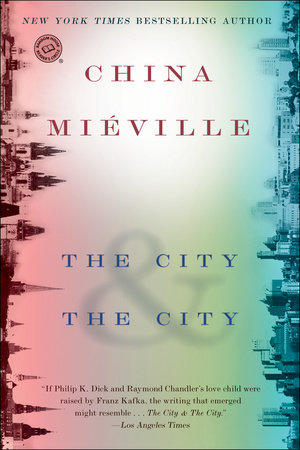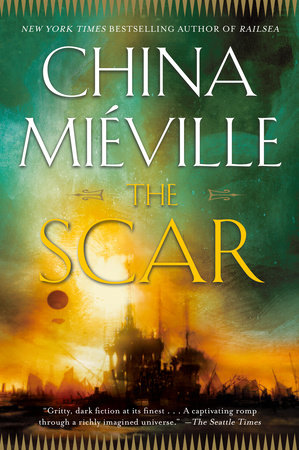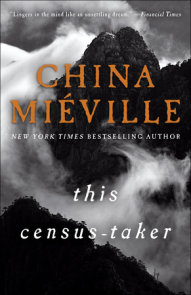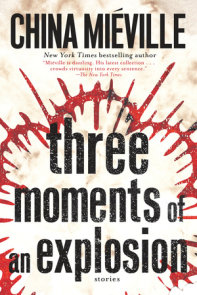Author Q&A
A Conversation with China Miéville
Award-winning author China Miéville’s third novel, THE SCAR, is a dark, rich tapestry of adventure and politics set on an incredible floating pirate city. In a recent interview, Miéville spoke with us about his inspirations and ideas for THE SCAR.
Q: THE SCAR and your last novel, PERDIDO STREET STATION, are set in the same world, but this time you take us much farther a field in the world of Bas Lag. How do you see the two stories as similar, and how different?
A: Most obviously, the stories are similar in that they are both very much urban, though the cities — Armada and New Crobuzon — are different in important ways. I’ve also carried on doing stuff I love, like inventing monsters, of which there are loads in THE SCAR. Setting the books in the same world gave me the chance to expand the world I’ve been creating. But there are some very important differences. The aesthetic, and the feeling of the two books are very different. Perdido Street Station was a book with a bleak story but a fairly traditional narrative structure. THE SCAR is a book that has a much more experimental — and bleaker — narrative structure. It’s also a book that’s structured more around the internal, emotional life of its characters. It’s more melancholic.
Q: THE SCAR further illuminates the political complexities of the world you’ve created. Did you set out to write an overtly political novel, or did your own real life experience with governments seep in?
A: It’s difficult to make that distinction. I don’t really set out to write political fiction as an end in itself — if I want to make political points, I write political articles — but to write fiction that would keep me interested. But the thing is that what keeps me interested, among other things, is politics, so I tend to put a lot of that stuff in the books. Also because it gives the world an awful lot more texture, and more realism, to make the political stuff in it as systematic and coherent as possible. My “real life experience” as a candidate for Parliament wasn’t so much an inspiration as my day-to-day experience as a political activist.
All fiction is political in some sense or other — but I’m interested in critical fiction (which doesn’t necessarily mean left-wing, of course) which is conscious of its own political engagement with the real world.
Q: Much of THE SCAR’s action takes place in Armada, a floating pirate city. Where did the idea for this story come from?
Most fundamentally, I’ve always loved underwater things – deepsea fish, diving, etc – and I had always wanted to write something that was set on, in and under the sea.
THE SCAR was conceived as a kind of response to the first book — Perdido Street Station — which was set in the same world. It isn’t really a sequel. Each book is a standalone, and it’s very important to me that they can be read in any order, or individually. But it is a response insofar as the tone and atmosphere are deliberately very different than that of Perdido Street Station. The response to that first book was so wonderful, that I was concerned that any follow-up would be a disappointment. So in a spirit of not-quite-contrariness but rather risk, I formulated THE SCAR to be the antithesis of the earlier book, yet still have an integrity and a sense of its own completeness. I was interested in taking those elements of the first book that had garnered the greatest response — the city, the sense of oppressive pell-mell rushing — and deliberately withhold them, or view them as if through gauze.
I am very much in love with the world I created in the first book, and I wanted to take the opportunity to visit some other parts of that world. So I focused on a maritime novel as the perfect opportunity to roam around the world, and to see fleeting glimpses of various other places, as well as to have a very different sense of scale than Perdido Street Station.
Q: Would you live in Armada if you could?
A: Yeah! Not because it would be nice — I think it would be a fairly awful place to live, much of the time — but because who could possibly turn down the opportunity to live in their own invented world? I’d go live in New Crobuzon too. I’d be shit-scared, though.
Q: Tell us a bit about the reading, research, or thinking you did to come up with Armada and its unique neighborhoods.
A: Most of the research I did was on the stuff about ship design. I spent loads of time looking up schematics of ships from all over the time and place. I read lots of children’s reference books when I’m researching — they tend to have enough detail to make things convincing, but not more than I need. And they have good pictures. I found loads of cool stuff online — downloaded a bunch of blueprints for oil rigs. Found loads of old names for different types of vessels. I read a lot of maritime fiction, of which an awful lot is riffed on in the book. You can find 20,000 Leagues Under The Sea, Boats of the Glen Carrig, Rites of Passage, “The Hunting of the Snark,” and lots else. The thing is that there is so much fiction set at sea and on ships that there are hugely strong clichés, so I needed to get to grips with all that stuff so that I didn’t unwittingly repeat them. To that extent I wanted to write an “anti-maritime” book.
I even forced myself to watch Waterworld for research purposes, so no one can say I haven’t suffered for my art.
Q: Do you think of either of the book’s two troubled protagonists — the linguist, Bellis Coldwine, and the freed prisoner, Tanner Sack — as heroic or as villainous?
A: Certainly not villainous at all. Heroic? Well, yes, but not in the traditional sense. They’re both very, very flawed, and more to the point, they’re both — particularly Bellis — very damaged. I know that being damaged doesn’t preclude being heroic. Tanner especially really wants good things for people. Bellis is more just trying to survive. In the genre/epic fantasy tradition, heroism seems defined by characters’ abilities to stamp their wills on history. None of my characters can do that. What they can do is change themselves and their surroundings, though history always constrains them. They both try to do the right thing, particularly Tanner, and they’re both different people at the end of the book. Heroic? I’m not sure.
Q: Uther Doul, Armada’s formidable defender, carries a very special blade which slices through possibility itself to brutal effect. The city of Armada goes on a treacherous voyage in search of the power to manipulate reality. Have you been reading up on quantum theory?
A: Only in the most crass and makeshift sense. I’d be deeply embarrassed to talk to a proper scientist as if I knew jack shit about quantum stuff. What’s important to me isn’t necessarily to be scientifically rigorous, but to be plausible. I pilfered just enough quantum stuff to make sense within the constraints of the world I created. More expertise than that I couldn’t possibly claim.
Q: So if THE SCAR were made into a big-screen Hollywood feature, what would be your ideal cast?
I love questions like this! Okay, Bellis Coldwine would be Carrie-Anne Moss. She’s a bit young, but with make-up…? Tanner Sack would be Sean Bean. For Uther Doul, I’d have Russell Crowe bulk up a bit. Sleazy Silas Fennec? Ralph Fiennes would be perfect. The Lovers? Anjelica Huston and Timothy Dalton
Q: Ah, Timothy Dalton?
A. It’s my movie – hush up! Brucolac would be Laurence Fishburne (whose wardrobe I would love to raid, by the way). Johannes Tearfly would be Malcolm McDowell because he excels at playing that type of pseudo-sympathetic megalomaniac. I’d also want it to feature Fairuza Balk, Don Cheadle and Demitri Goritsas.
Q: Okay, back to the real world now…Admirers of your books sometimes call them “steampunk,” finding both “science fiction” and “fantasy” inadequate, given popular conceptions of those genres. Does that label suit you? What do you call your work?
A: Sure. I’ll take whatever labels people want to hand out. To be honest, I find the whole debate about “is it science fiction, is it fantasy (or is it even horror?)” kind of academic. I’ve had “steampunk,” I’ve had “grunge fantasy” — none of them bother me. I have always been openly critical of the post-Tolkien genre of epic or quest fantasy. People associate fantasy with elves, dwarfs and wizards. My books have none of that – THE SCAR is full of ironclad battleships, dirigibles, swearing, sex and violence.
I think it is worth pointing out that this book and my last book blur the boundaries between SF and fantasy. Perdido Street Station won both a fantasy prize and a science fiction prize. I consider myself to be writing in an older tradition than Tolkien’s notion of fantasy. If I’m talking to somebody who knows a little bit about the field of SF, etc., then I describe what I write as Weird Fiction — because the writers in the Weird Tales tradition did a very good job of blurring the boundaries between the various realms of the fantastic.
To the mainstream, it could be pointed out that I am unapologetic about genre, but try to write with a more ‘literary’ sensibility. It’s been said several times that this is the kind of fantasy that people who don’t think they like fantastic literature might enjoy. I am quite argumentative in my attacks on mainstream critics for being short-sighted about genre, and enjoy pointing out to them that plenty of ‘their’ classics are in fact ‘ours’ (The Master and Margerita, Metamorphosis, Toni Morrison’s Beloved, any Isabel Allende novel). I would love to get the chance to get into mainstream books publications and make the case for fantastic literature.
Q: In the past, you’ve cited Mervyn Peake and M. John Harrison, among others, as special influences, but your style is evolving with each novel. Was there anything — music, images, books — that was especially inspiring while you worked on THE SCAR?
A: The single strongest influence on me for this book were the writings of the Zimbabwean author Dambudzo Marechera. He is an astounding figure, a self-taught writer who wrestles with the English language, reinvigorating it. He’s a modernist, unlike so many African writers who are part of a social realist or a folklorist tradition. The epigram from his book Black Sunlight informs the whole book — he has a wonderfully empathetic and moving sense of humans as the sum of all their damage, but no less important for that.
Other stuff: music — particularly Benjamin Britten’s chamber music and solo cello suites. Images: stuff from Moby Dick, and basically every single underwater monster from films, comics, and all the other cultural bumph I could sift through. It’s not really inspiration, but there is a massive riff on ‘The Hunting of the Snark’ in there. As well as one of the Narnia books — which I dislike a lot and have wreaked revenge on.
Q: Will we see more novels set in the world of Bas Lag?
A: The next book, the one I’m writing now, is set in the same world. After that, I’m not committed, and I might change settings for a while. I would be extremely surprised, though, if I never go back there. There are too many other places to go in this world. I’m enjoying it too much not to go back.































